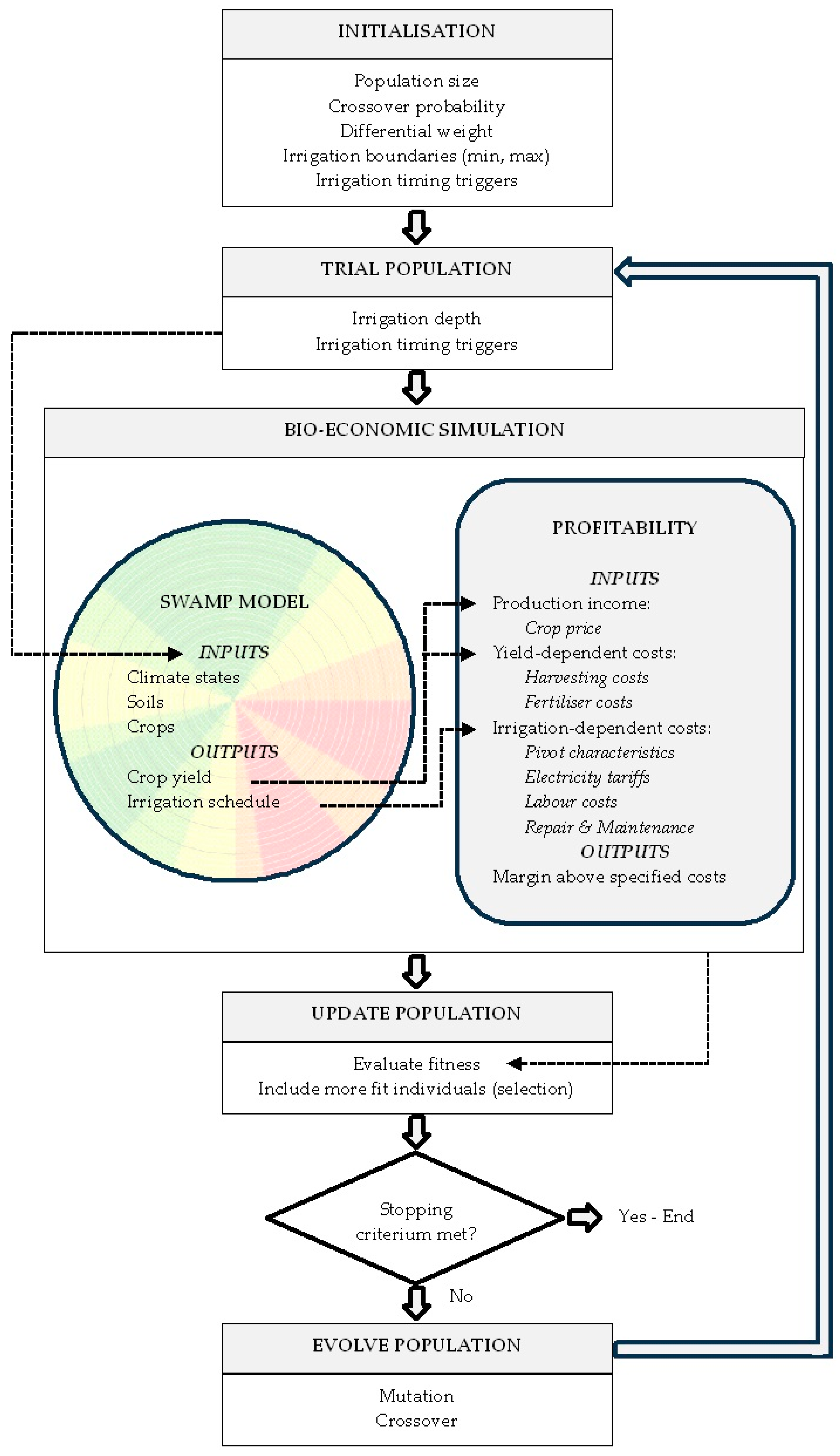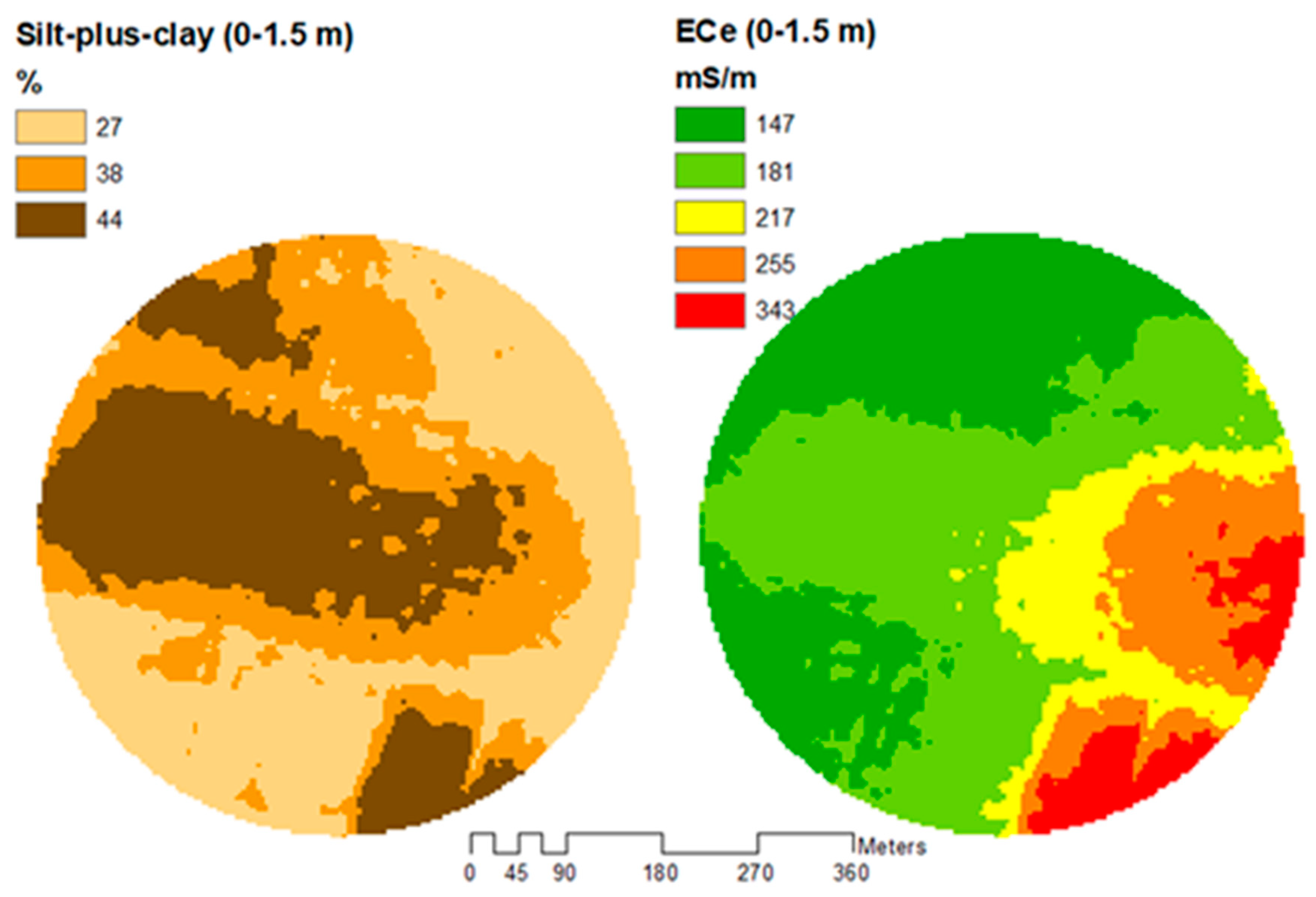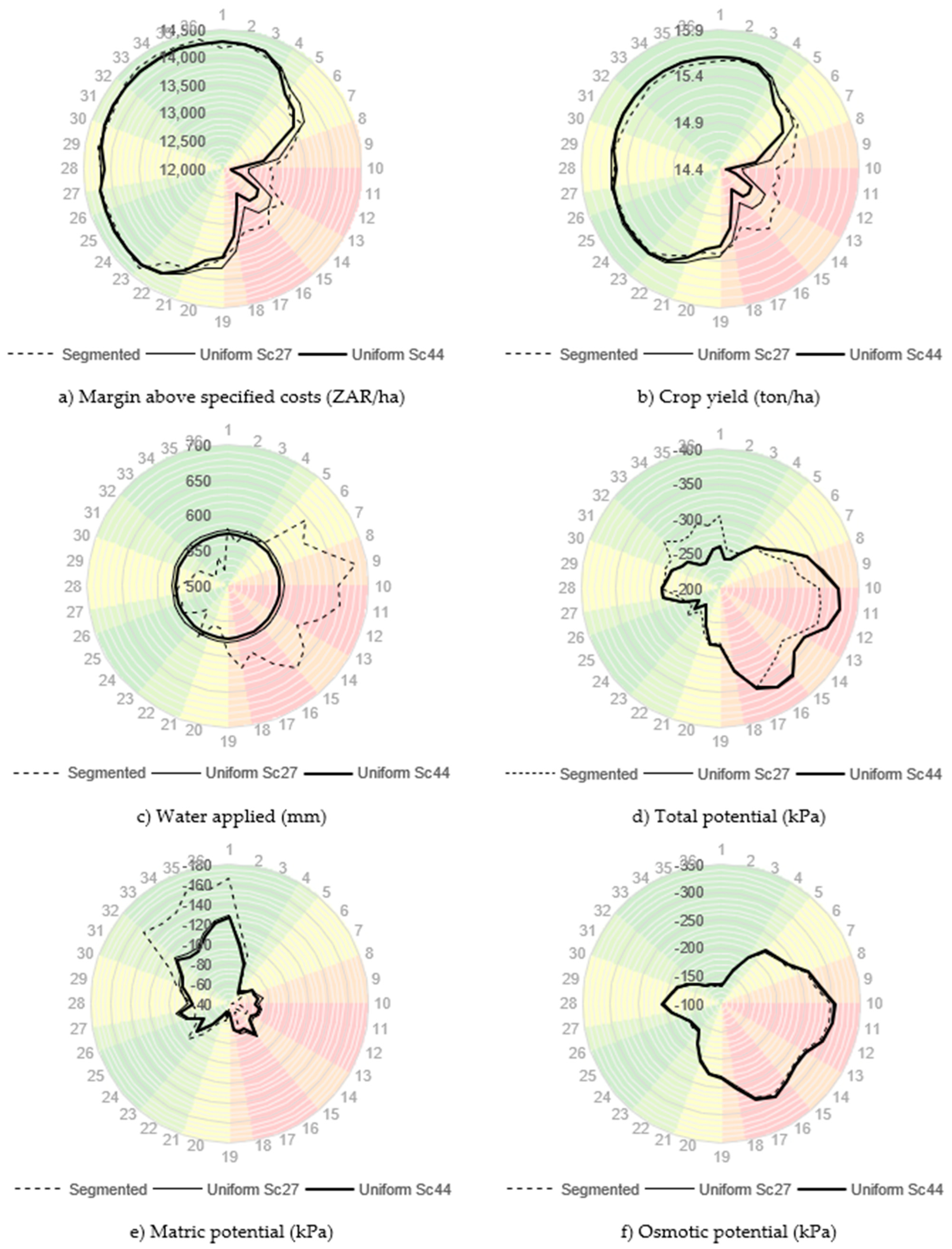Economic Analysis of Segmented Soil Salinity Management Using Current Irrigation Technology
Abstract
1. Introduction
2. Methods and Data
2.1. Bioeconomic Optimisation Model
2.1.1. Overview
2.1.2. Crop Yield Simulation
2.1.3. Profitability Calculation
2.2. Case Study Data
2.3. Bioeconomic Model Application
2.3.1. Segmented Irrigation Strategy
2.3.2. Uniform Strategy
3. Results
3.1. Economic Benefit of Segmented Salinity Management
3.2. Segmented Variability of Key Output Variables
4. Discussion and Conclusions
Supplementary Materials
Author Contributions
Funding
Institutional Review Board Statement
Data Availability Statement
Acknowledgments
Conflicts of Interest
References
- Gu, Z.; Qi, Z.; Burghate, R.; Yuan, S.; Jiao, X.; Xu, J. Irrigation Scheduling Approaches and Applications: A Review. J. Irrig. Drain. Eng. 2020, 146, 04020007. [Google Scholar] [CrossRef]
- Wichelns, D.; Qadir, M. Achieving sustainable irrigation requires effective management of salts, soil salinity, and shallow groundwater. Agric. Water Manag. 2015, 157, 31–38. [Google Scholar] [CrossRef]
- Singh, A. Soil salinization management for sustainable development: A review. J. Environ. Manag. 2021, 277, 111383. [Google Scholar] [CrossRef]
- Shahid, S.A.; Zaman, M.; Heng, L. Soil Salinity: Historical Perspectives and a World Overview of the Problem. In Guideline for Salinity Assessment, Mitigation and Adaptation Using Nuclear and Related Techniques; Springer: Cham, Switzerland, 2018; pp. 43–53. [Google Scholar]
- Mukhopadhyay, R.; Sarkar, B.; Jat, H.S.; Sharma, P.C.; Bolan, N.S. Soil salinity under climate change: Challenges for sustainable agriculture and food security. J. Environ. Manag. 2021, 280, 111736. [Google Scholar] [CrossRef]
- Barnard, J.H.; Matthews, N.; du Preez, C.C. Formulating and assessing best water and salt management practices: Lessons from non-saline and water-logged irrigated fields. Agric. Water Manag. 2021, 247, 106706. [Google Scholar] [CrossRef]
- Minhas, P.S.; Ramos, T.B.; Ben-Gal, A.; Pereira, L.S. Coping with salinity in irrigated agriculture: Crop evapotranspiration and water management issues. Agric. Water Manag. 2020, 227, 105832. [Google Scholar] [CrossRef]
- Taha, M.F.; Mao, H.; Zhang, Z.; Elmasry, G.; Awad, M.A.; Abdalla, A.; Mousa, S.; Elwakeel, A.E.; Elsherbiny, O. Emerging Technologies for Precision Crop Management Towards Agriculture 5.0: A Comprehensive Overview. Agriculture 2025, 15, 582. [Google Scholar] [CrossRef]
- Ray, S.; Majumder, S. Water management in agriculture: Innovations for efficient irrigation. In Modern Agronomy; Sil, P., Chhetri, P., Majumder, S., Santosh, D.T., Eds.; Satish Serial Publishing House: New Delhi, India, 2024; pp. 169–185. [Google Scholar]
- Su, Q.; Singh, V.P. Advancing irrigation management: Integrating technology and sustainability to address global food security. Environ. Monit. Assess. 2024, 196, 1018. [Google Scholar] [CrossRef]
- Monteiro, A.; Santos, S.; Goncalves, P. Precision Agriculture for Crop and Livestock Farming-Brief Review. Animals 2021, 11, 2345. [Google Scholar] [CrossRef]
- Galioto, F.; Raggi, M.; Viaggi, D. Assessing the Potential Economic Viability of Precision Irrigation: A Theoretical Analysis and Pilot Empirical Evaluation. Water 2017, 9, 990. [Google Scholar] [CrossRef]
- Galioto, F.; Chatzinikolaou, P.; Raggi, M.; Viaggi, D. The value of information for the management of water resources in agriculture: Assessing the economic viability of new methods to schedule irrigation. Agric. Water Manag. 2020, 227, 105848. [Google Scholar] [CrossRef]
- Dissanayake, C.A.K.; Jayathilake, W.; Wickramasuriya, H.V.A.; Dissanayake, U.; Kopiyawattage, K.P.P.; Wasala, W.M.C.B. Theories and Models of Technology Adoption in Agricultural Sector. Hum. Behav. Emerg. Technol. 2022, 2022, 9258317. [Google Scholar] [CrossRef]
- Finger, R.; Swinton, S.M.; El Benni, N.; Walter, A. Precision Farming at the Nexus of Agricultural Production and the Environment. Annu. Rev. Resour. Econ. 2019, 11, 313–335. [Google Scholar] [CrossRef]
- Masi, M.; Di Pasquale, J.; Vecchio, Y.; Capitanio, F. Precision Farming: Barriers of Variable Rate Technology Adoption in Italy. Land 2023, 12, 1084. [Google Scholar] [CrossRef]
- Sadler, E.J.; Evans, R.G.; Stone, K.C.; Camp, C.R. Opportunities for conservation with precision irrigation. J. Soil Water Conserv. 2005, 60, 371–379. [Google Scholar]
- Kakkavou, K.; Gemtou, M.; Fountas, S. Drivers and barriers to the adoption of precision irrigation technologies in olive and cotton farming—Lessons from Messenia and Thessaly regions in Greece. Smart Agric. Technol. 2024, 7, 100401. [Google Scholar] [CrossRef]
- Lahiri, R.; Ding, J.; Chinzara, Z. Technology adoption, adaptation and growth. Econ. Model. 2018, 70, 469–483. [Google Scholar] [CrossRef]
- Yadegari, M.; Mohammadi, S.; Masoumi, A.H. Technology adoption: An analysis of the major models and theories. Technol. Anal. Strateg. Manag. 2022, 36, 1096–1110. [Google Scholar] [CrossRef]
- Rogers, E.M. Diffusion of Innovations; The Free Press: New York, NY, USA, 1983. [Google Scholar]
- Chen, F.; Zhao, H.; Roberts, D.; Van de Voorde, T.; Batelaan, O.; Fan, T.; Xu, W. Mapping center pivot irrigation systems in global arid regions using instance segmentation and analyzing their spatial relationship with freshwater resources. Remote Sens. Environ. 2023, 297, 113760. [Google Scholar] [CrossRef]
- Bilal; Pant, M.; Zaheer, H.; Garcia-Hernandez, L.; Abraham, A. Differential Evolution: A review of more than two decades of research. Eng. Appl. Artif. Intell. 2020, 90, 24. [Google Scholar] [CrossRef]
- Hadebe, R.; Grové, B.; Matthews, N.; Barnard, J. Bio-economic analysis of irrigation schedules considering shallow groundwater: Lessons from South Africa. Appl. Water Sci. 2024, 14, 190. [Google Scholar] [CrossRef]
- Storn, R.; Price, K. Differential evolution—A fast and efficient heuristic for global optimization over continuous spaces. J. Glob. Optim. 1997, 11, 341–359. [Google Scholar] [CrossRef]
- Tenreiro, T.R.; García-Vila, M.; Gómez, J.A.; Jimenez-Berni, J.A.; Fereres, E. Water modelling approaches and opportunities to simulate spatial water variations at crop field level. Agric. Water Manag. 2020, 240, 106254. [Google Scholar] [CrossRef]
- Bennie, A.T.P.; Strydom, M.; Vrey, H. Use of Computer Models for Agricultural Water Management on Ecotope Level; Water Resources Commission: Pretoria, South Africa, 1998. [Google Scholar]
- Barnard, J.H.; van Rensburg, L.D.; Bennie, A.T.P.; du Preez, C.C. Simulating water uptake of irrigated field crops from non-saline water table soils: Validation and application of the model SWAMP. Agric. Water Manag. 2013, 126, 19–32. [Google Scholar] [CrossRef]
- Barnard, J.H.; Bennie, A.T.P.; van Rensburg, L.D.; Preez, C.C.d. SWAMP: A soil layer water supply model for simulating macroscopic crop water uptake under osmotic stress. Agric. Water Manag. 2015, 148, 150–163. [Google Scholar] [CrossRef]
- Barnard, J.H.; du Preez, C.C. Spatial characterization of total salt in non-saline soil solutions through electromagnetic induction. Catena 2022, 216, 106395. [Google Scholar] [CrossRef]
- Eskom, L. Tariffs & Charges Booklet 2019/2020. 2019. Available online: https://www.eskom.co.za/distribution/wp-content/uploads/2021/07/2019-20.pdf (accessed on 8 May 2020).
- Oosthuizen, L.K.; Botha, P.W.; Grové, B.; Meiring, J.A. Cost-estimating procedures for drip-, micro- and furrow-irrigation systems. Water SA 2005, 31, 403–406. [Google Scholar]
- Griekwaland-Wes, K. Input Cost Guide. 2019. Available online: https://info.profarmer.co.za/ (accessed on 8 May 2020).
- Barnard, J.H. Leaching of Excess Salts from the Root Zone of Apedal Soils. Master’s Dissertation, University of the Free State, Bloemfontein, South Africa, 2006. [Google Scholar]
- Ritzema, H.P. Drain for Gain: Managing salinity in irrigated lands—A review. Agric. Water Manag. 2016, 176, 18–28. [Google Scholar] [CrossRef]
- Qin, A.; Ning, D.; Liu, Z.; Li, S.; Zhao, B.; Duan, A. Determining Threshold Values for a Crop Water Stress Index-Based Center Pivot Irrigation with Optimum Grain Yield. Agriculture 2021, 11, 958. [Google Scholar] [CrossRef]
- Fernández, J.E.; Alcon, F.; Diaz-Espejo, A.; Hernandez-Santana, V.; Cuevas, M.V. Water use indicators and economic analysis for on-farm irrigation decision: A case study of a super high density olive tree orchard. Agric. Water Manag. 2020, 237, 106074. [Google Scholar] [CrossRef]
- Liu, L.; Zuo, Q.; Shi, J.; Wu, X.; Wei, C.; Sheng, J.; Jiang, P.; Chen, Q.; Ben-Gal, A. Balancing economic benefits and environmental repercussions based on smart irrigation by regulating root zone water and salinity dynamics. Agric. Water Manag. 2023, 285, 108366. [Google Scholar] [CrossRef]
- Pereira, L.S.; Duarte, E.; Fragoso, R. Water use: Recycling and desalinisation for agriculture. In Encyclopedia of Agriculture and Food Systems; van Alfen, N., Ed.; Elsevier: San Diego, CA, USA, 2014; Volume 5, pp. 407–424. [Google Scholar]
- Karimzadeh, S.; Hartman, S.; Chiarelli, D.D.; Rulli, M.C.; D’Odorico, P. The tradeoff between water savings and salinization prevention in dryland irrigation. Adv. Water Resour. 2024, 183, 104604. [Google Scholar] [CrossRef]
- Hoffmann, P.; Villamayor-Tomas, S. Irrigation modernization and the efficiency paradox: A meta-study through the lens of Networks of Action Situations. Sustain. Sci. 2023, 18, 181–199. [Google Scholar] [CrossRef]
- De Wit, C.T. Transpiration and Crop Yields; Institute of Biological and Chemical Research on Field Cops and Herbage: Wageningen, The Netherlands, 1958. [Google Scholar]
- Hanks, R.J.; Rasmussen, V.P. Predicting crop production as related to plant water stress. Adv. Agron. 1982, 35, 193–215. [Google Scholar]
- Ratliff, L.F.; Ritchie, J.T.; Cassel, D.K. Field-measured limits of soil water availability as related to laboratory-measured properties. Soil Sci. Soc. Am. J. 1983, 47, 770–775. [Google Scholar] [CrossRef]
- Barnard, J.H.; van Rensburg, L.D.; Bennie, A.T.P. Leaching irrigated saline sandy to sandy loam apedal soils with water of a constant salinity. Irrig. Sci. 2010, 28, 191–201. [Google Scholar] [CrossRef]
- Philip, J.R. Plant water relations. Some physical aspects. Annu. Rev. Plant Biol. 1966, 17, 245–268. [Google Scholar] [CrossRef]
- Steduto, P.; Hsiao, T.C.; Fereres, E.; Raes, D. Crop Yield Response to Water; Food and Agriculture Organization: Rome, Italy, 2012. [Google Scholar]
- Geonics, L. EM38-MK2 Ground Conductivity Meter Operational Manual; Geonics Limited: Mississauga, ON, Canada, 2008. [Google Scholar]
- Sudduth, K.A.; Drummond, S.T.; Kitchen, N.R. Accuracy issues in electromagnetic induction sensing of soil electrical conduction for precision agriculture. Comput. Electron. Agric. 2001, 31, 239–264. [Google Scholar] [CrossRef]
- Lesch, S.M.; Strauss, D.J.; Rhoades, J.D. Spatial prediction of soil salinity using electromagnetic induction techniques: 2. An efficient spatial sampling algorithm suitable for multiple linear regression model identification and estimation. Water Resour. Res. 1995, 31, 387–398. [Google Scholar] [CrossRef]
- Lesch, S.M.; Rhoades, J.D.; Corwin, D.L. ESAP-95 Version 2.10R: User and Tutorial Guide; US Salinity Laboratory: Riverside, CA, USA, 2000. [Google Scholar]
- Non-Affiliated Soil Analysis Working Group. Handbook of Standard Soil Testing Methods for Advisory Purposes; Soil Science Society of South Africa: Pretoria, South Africa, 1990. [Google Scholar]
- Corwin, D.L.; Scudiero, E. Field-scale apparent soil electrical conductivity. Soil Sci. Soc. Am. J. 2020, 84, 1405–1441. [Google Scholar] [CrossRef]
- Matthews, N.; Grové, B.; Barnard, J.H. Economic Management of Water and Salt Stress for Irrigated Agriculture: A Precision Agriculture Case Study; WRC Report No. 2708/1/21; Water Resources Commission: Pretoria, South Africa, 2022. [Google Scholar]




| Maize price | ZAR/ton | 2570 |
| Potential yield | ton/ha | 15.5 |
| Yield-dependent costs | ZAR/ton | 700.16 |
| Area-dependent cost | ZAR/ha | 12,897 |
| Irrigation-dependent cost | ZAR/hour | 19.35 |
| Silt-Plus-Clay Category Soil | Margin Above the Specified Cost | Benefit * | ||||
|---|---|---|---|---|---|---|
| Baseline | Segmented | |||||
| ZAR | ZAR/ha | ZAR | ZAR/ha | ZAR | ZAR/ha | |
| Sc27 | 345,994 | 13,783 | 347,030 | 13,824 | 1086 | 41 |
| Sc38 | 343,644 | 13,689 | 3386 | 135 | ||
| Sc44 | 342,982 | 13,663 | 4048 | 161 | ||
Disclaimer/Publisher’s Note: The statements, opinions and data contained in all publications are solely those of the individual author(s) and contributor(s) and not of MDPI and/or the editor(s). MDPI and/or the editor(s) disclaim responsibility for any injury to people or property resulting from any ideas, methods, instructions or products referred to in the content. |
© 2025 by the authors. Licensee MDPI, Basel, Switzerland. This article is an open access article distributed under the terms and conditions of the Creative Commons Attribution (CC BY) license (https://creativecommons.org/licenses/by/4.0/).
Share and Cite
Matthews, N.; Grové, B.; Barnard, J.H. Economic Analysis of Segmented Soil Salinity Management Using Current Irrigation Technology. Agriculture 2025, 15, 850. https://doi.org/10.3390/agriculture15080850
Matthews N, Grové B, Barnard JH. Economic Analysis of Segmented Soil Salinity Management Using Current Irrigation Technology. Agriculture. 2025; 15(8):850. https://doi.org/10.3390/agriculture15080850
Chicago/Turabian StyleMatthews, Nicolette, Bennie Grové, and Johannes Hendrikus Barnard. 2025. "Economic Analysis of Segmented Soil Salinity Management Using Current Irrigation Technology" Agriculture 15, no. 8: 850. https://doi.org/10.3390/agriculture15080850
APA StyleMatthews, N., Grové, B., & Barnard, J. H. (2025). Economic Analysis of Segmented Soil Salinity Management Using Current Irrigation Technology. Agriculture, 15(8), 850. https://doi.org/10.3390/agriculture15080850






